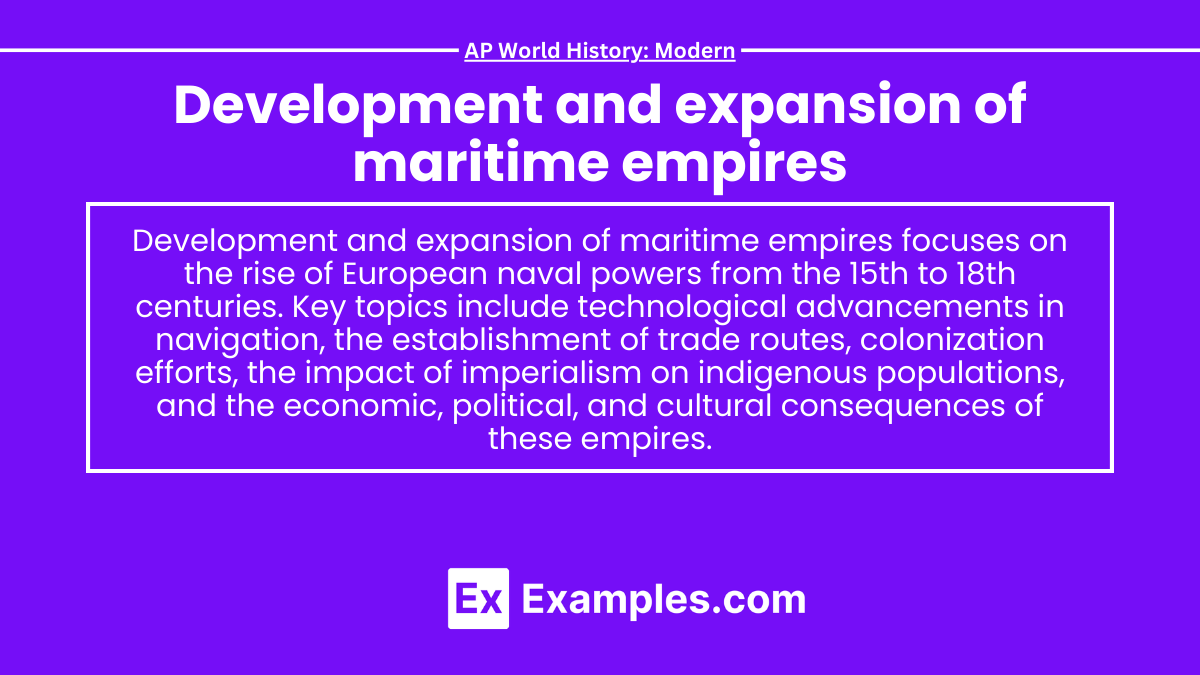The development and expansion of maritime empires from the 15th to 18th centuries transformed global trade, politics, and culture. European powers like Spain, Portugal, England, France, and the Netherlands used advanced navigation and shipbuilding techniques to establish vast overseas colonies, dominating trade routes. This era marked the beginning of globalization, significantly impacting indigenous societies, economies, and cultural exchanges worldwide.
Learning objective
In studying Development and Expansion of Maritime Empires for AP World History: Modern, you should learn to identify the key motivations behind European maritime exploration, including economic, religious, and political factors. Analyze how technological advancements in navigation and shipbuilding facilitated the establishment of overseas colonies and trade networks. Evaluate the impacts of maritime empires on indigenous populations, global trade, and the spread of European culture, as well as how competition between empires influenced global power dynamics and contributed to conflicts. Additionally, explore the role of mercantilism and the transatlantic slave trade in the expansion of these empires.
1. The Rise of Maritime Empires
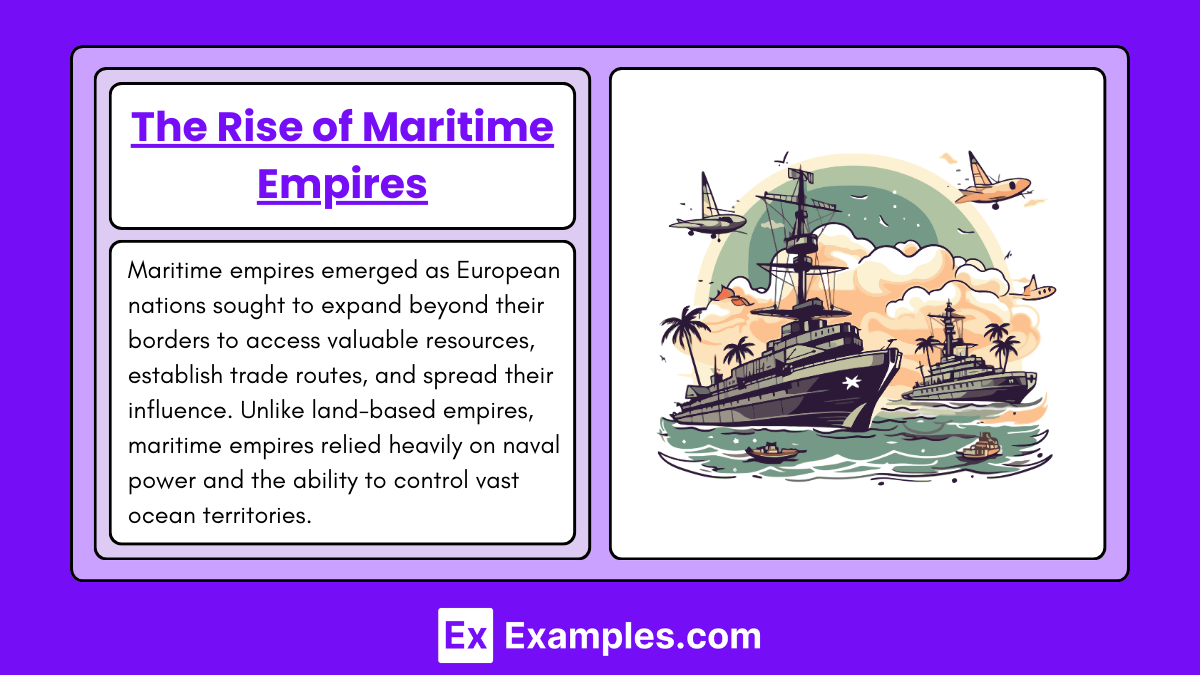
- Maritime empires emerged as European nations sought to expand beyond their borders to access valuable resources, establish trade routes, and spread their influence. Unlike land-based empires, maritime empires relied heavily on naval power and the ability to control vast ocean territories.
- Spain and Portugal were the trailblazers of maritime exploration, with Portugal focusing on Africa and Asia and Spain on the Americas. Their success motivated other European powers, like England, France, and the Netherlands, to pursue their own maritime ambitions.
- The Treaty of Tordesillas (1494) played a critical role in dividing the newly discovered lands between Spain and Portugal, allowing them to establish their respective empires without conflict, at least initially.
2. Technological Innovations in Navigation

- The success of maritime expansion was fueled by significant technological advancements that made long-distance sea travel possible:
- Caravel: The caravel was a highly maneuverable ship developed by the Portuguese, characterized by its lateen (triangular) sails. These sails allowed it to sail more effectively against the wind, making it suitable for exploring coastlines and open seas.
- Astrolabe: This device, adopted from the Islamic world, allowed sailors to determine latitude by measuring the angle between the horizon and a celestial body (such as the sun or a star), enabling more precise navigation.
- Magnetic Compass: Originally invented in China, the magnetic compass became a crucial navigational tool for European explorers, helping them maintain direction even when out of sight of land.
- Cartography (Map-making): Improved cartography provided more accurate maps and charts, essential for planning and executing long voyages. Explorers could rely on these maps to navigate unfamiliar waters and claim new territories.
3. Key Players in Maritime Expansion
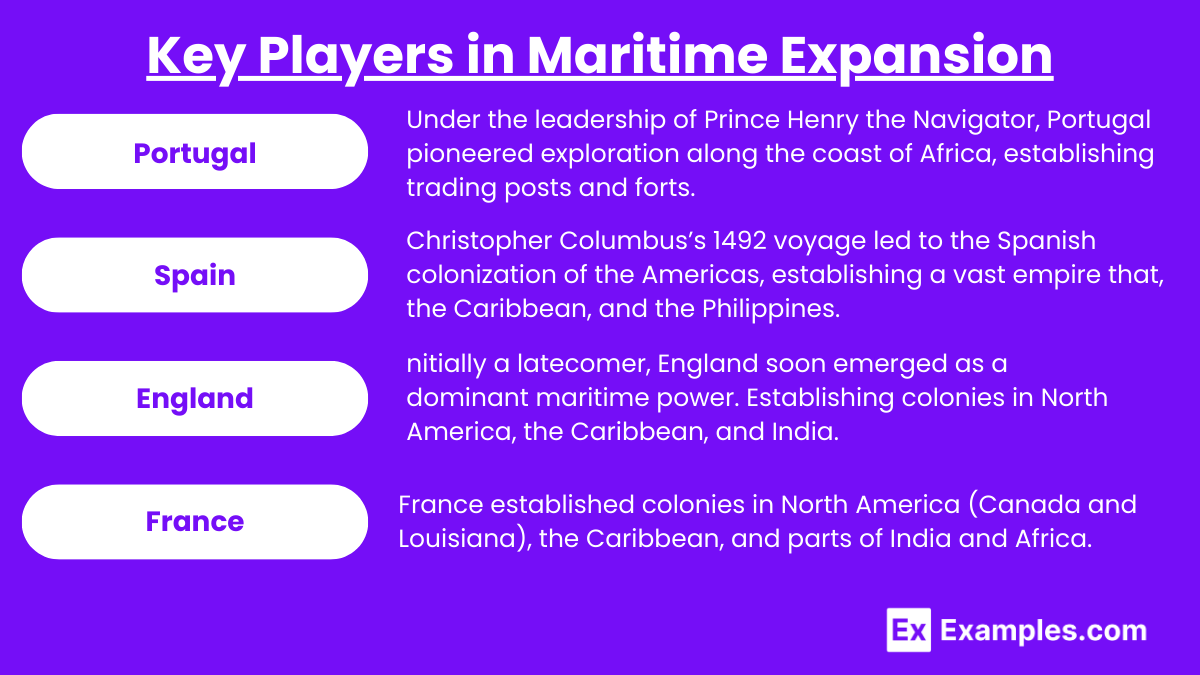
- Each European maritime empire had unique strategies, goals, and territories they controlled:
- Portugal: Under the leadership of Prince Henry the Navigator, Portugal pioneered exploration along the coast of Africa, establishing trading posts and forts. Vasco da Gama’s voyage to India in 1498 opened lucrative spice trade routes, securing Portuguese dominance in the Indian Ocean.
- Spain: Christopher Columbus’s 1492 voyage led to the Spanish colonization of the Americas, establishing a vast empire that included much of South and Central America, the Caribbean, and the Philippines. The Spanish exploited the wealth of the New World, particularly silver and gold, fueling their economy.
- England: Initially a latecomer, England soon emerged as a dominant maritime power. Establishing colonies in North America, the Caribbean, and India, England developed a powerful navy and trading networks that would later become the foundation of the British Empire.
- France: France established colonies in North America (Canada and Louisiana), the Caribbean, and parts of India and Africa. French influence in the fur trade, sugar plantations, and Indian Ocean trade routes made it a formidable maritime empire.
4. Colonization and Control of Territories
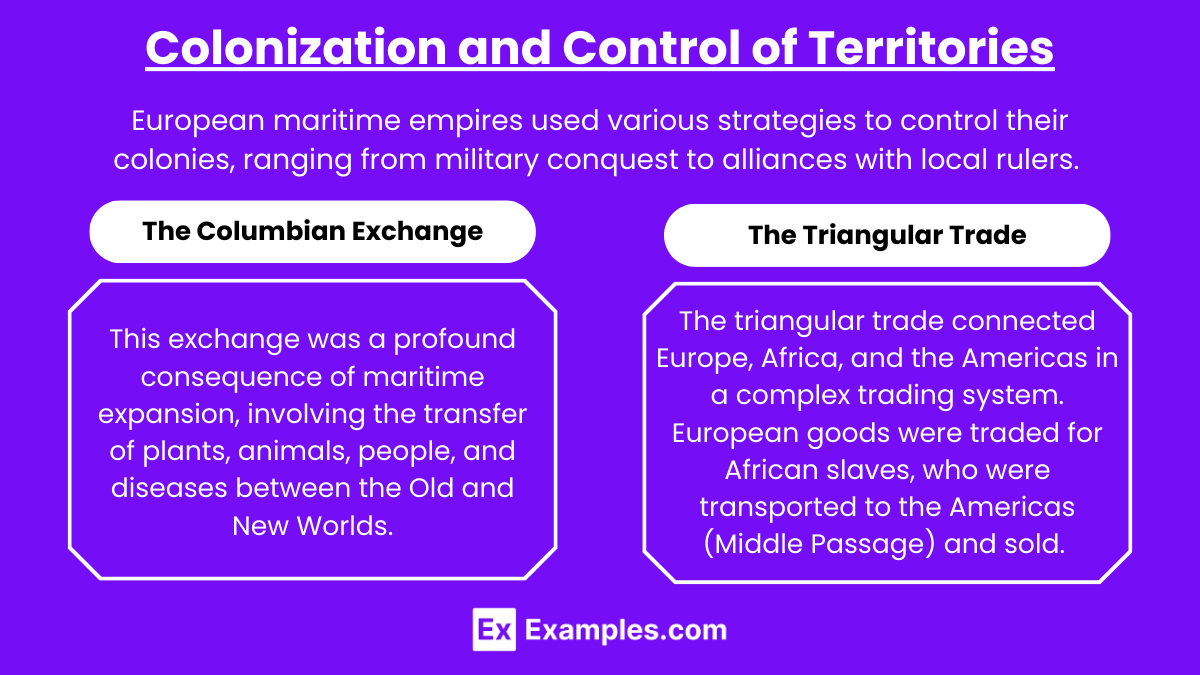
- European maritime empires used various strategies to control their colonies, ranging from military conquest to alliances with local rulers. They established a network of forts, trading posts, and settlements to secure their presence and protect their interests.
- The Columbian Exchange: This exchange was a profound consequence of maritime expansion, involving the transfer of plants, animals, people, and diseases between the Old and New Worlds. It led to the introduction of crops like potatoes, maize, and tomatoes to Europe and sugar, coffee, and livestock to the Americas. However, diseases such as smallpox decimated indigenous populations, dramatically altering societies in the Americas.
- The Triangular Trade: The triangular trade connected Europe, Africa, and the Americas in a complex trading system. European goods were traded for African slaves, who were transported to the Americas (Middle Passage) and sold. The profits were then used to buy raw materials like sugar, tobacco, and cotton, which were shipped back to Europe.
5. Impact on Indigenous Populations and African Societies
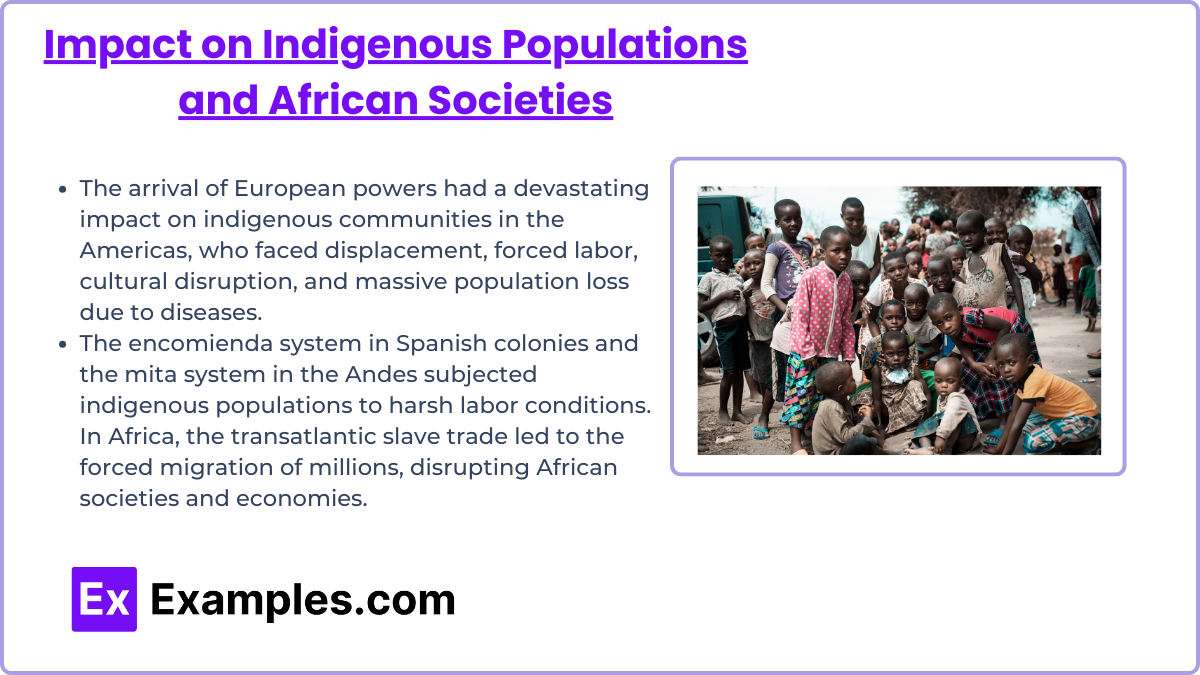
- The arrival of European powers had a devastating impact on indigenous communities in the Americas, who faced displacement, forced labor, cultural disruption, and massive population loss due to diseases.
- The encomienda system in Spanish colonies and the mita system in the Andes subjected indigenous populations to harsh labor conditions. In Africa, the transatlantic slave trade led to the forced migration of millions, disrupting African societies and economies.
- Indigenous and African resistance was common, with leaders like Túpac Amaru II in Peru and Queen Nanny of the Jamaican Maroons leading rebellions against European dominance.
Examples
Example 1: Portugal’s Exploration of Africa and Asia
Portugal led early maritime exploration, establishing trading posts in Africa and Asia. Vasco da Gama’s voyage to India in 1498 secured lucrative spice trade routes.
Example 2: Spain’s Colonization of the Americas
Spain’s conquest of the Aztec and Inca Empires expanded its maritime empire, extracting vast wealth from silver and gold mines, transforming global economies and trade networks.
Example 3: England’s Control of North America and the Caribbean
England established colonies in North America and the Caribbean, exploiting resources like tobacco and sugar. These colonies became key to England’s wealth and maritime dominance.
Example 4: Dutch Expansion in Southeast Asia
The Dutch East India Company (VOC) dominated spice trade routes in Southeast Asia. It controlled key ports and trade routes, becoming a powerful maritime and commercial empire.
Example 5: French Colonization in North America and the Caribbean
France established colonies in Canada, the Mississippi River Valley, and the Caribbean, focusing on fur trade and sugar plantations, expanding its influence and economic power overseas.
MCQs
Question 1
Which technological advancement significantly contributed to the success of maritime empires by allowing European explorers to navigate longer distances across the open sea?
A) Steam engine
B) Caravel
C) Printing press
D) Gunpowder
Answer: B) Caravel
Explanation:
The caravel was a highly maneuverable ship developed by the Portuguese. It had lateen sails, enabling it to sail effectively against the wind. This innovation allowed European explorers to travel longer distances, navigate coastlines, and explore uncharted waters, which was essential for establishing and expanding maritime empires.
Question 2
Which of the following was a major economic policy that guided European maritime empires in their quest to accumulate wealth and expand their overseas colonies?
A) Capitalism
B) Mercantilism
C) Feudalism
D) Socialism
Answer: B) Mercantilism
Explanation:
Mercantilism was an economic policy that emphasized accumulating wealth through a favorable balance of trade. European empires sought to acquire colonies as sources of raw materials and markets for manufactured goods, aiming to increase national wealth. This policy drove the development and expansion of maritime empires, leading to intense competition among European powers.
Question 3
Which European power established the first major trading posts along the African coast and controlled the spice trade in the Indian Ocean by the early 16th century?
A) England
B) France
C) Portugal
D) The Netherlands
Answer: C) Portugal
Explanation:
Portugal was the first European power to establish trading posts along the African coast and gain control of the spice trade in the Indian Ocean. Portuguese explorers, such as Vasco da Gama, successfully reached India by sea, allowing Portugal to dominate the spice trade and establish a network of trading posts, which expanded its maritime empire.

